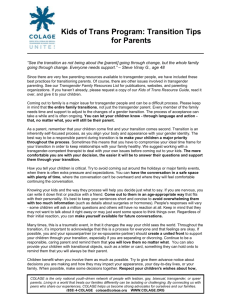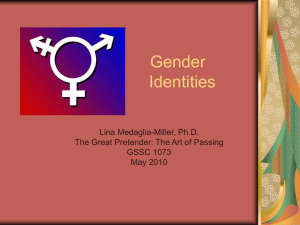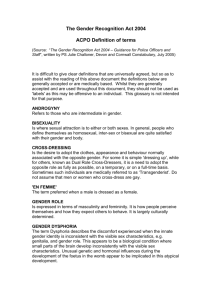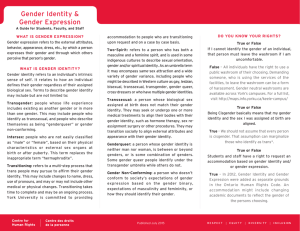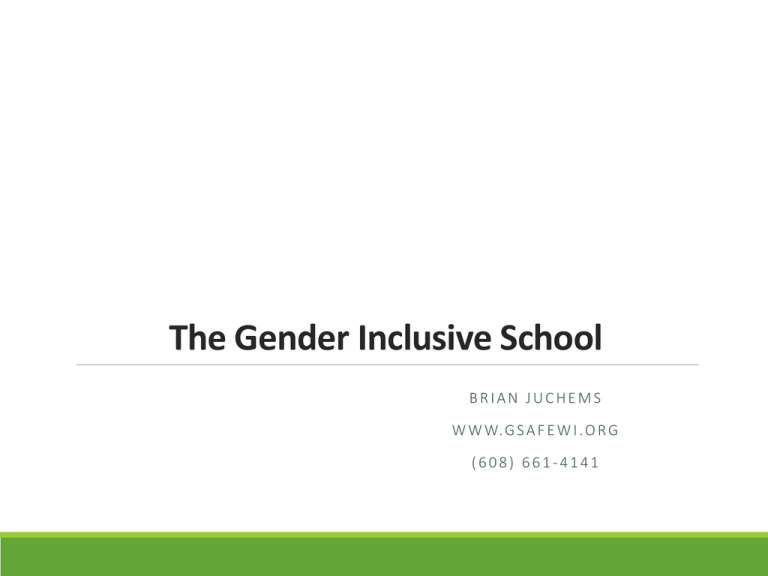
The Gender Inclusive School
BRIAN JUCHEMS
W W W. G S A F E W I . O R G
(608) 661-4141
Developing the leadership of LGBTQ+ and allied youth
Supporting Gay-Straight Alliances
Training educational staff
Advancing educational justice
Deepening racial, trans*, gender, and social justice
www.gsafewi.org
My Gender Journey
1. Growing up, did you think of yourself as a boy, a girl, both,
neither or in some way? How did you come to that recognition?
When?
2. What messages did you receive from those around you about
gender? Did those messages make sense to you?
3. How were students who did not fit into expectations about
gender treated in school by other students? By the adults
around them? By you?
4. Have you ever been confused by someone’s gender? How did
that feel for you? Why do you think you felt the way you did?
5. If you were to describe your gender without talking about how
you look or what you do, what would you share?
6. How have issues of gender and gender diversity “shown up” in
your work as an educator or in your role at school?
Source: Gender Spectrum
Biological Sex
Male
Intersex
Anatomy
Chromosomes
Hormones
Female
http://tinyurl.com/intersexy
Gender
Gender Roles
(societal expectation of gender - racialized)
male
female
Gender Expression
(communication of gender)
masculine
androgynous
feminine
Agender
Gender Identity
(psychological sense of self, “brain gender”)
man
genderqueer
woman
Gender
Gender Roles
(societal expectation of gender)
male
female
Gender impacts
all students
GENDER INCLUSIVE SCHOOLS HELP ALL STUDENTS
Gender
Gender Roles
(societal expectation of gender)
male
female
Gender Expression
(communication of gender)
masculine
androgynous
feminine
Who is
this?
"The generally accepted rule is pink
for the boys, and blue for the girls.
The reason is that pink, being a more
decided and stronger color, is more
suitable for the boy, while blue,
which is more delicate and dainty, is
prettier for the girl."
-- Ladies Home Journal
1918
Gender
Gender Roles
(societal expectation of gender)
male
female
Gender Expression
(communication of gender)
masculine
androgynous
Gender Identity
feminine
Agender
(psychological sense of self, “brain gender”)
man
genderqueer/two spirit
woman
Cisgender: A person whose gender identity more or less aligns with the
biological sex they were assigned at birth. (“cis-” is a Latin prefix meaning “on
this side of”)
cisgender
cisgender
Transgender: A person whose gender identity is different from the biological sex
they were assigned at birth. (“trans-” is a Latin prefix meaning “across, on the far
side of”)
biological sex
female
male
gender identity
man
woman
Evidence of gender diverse
identities and behaviors exists
throughout history and across
cultures.
“Transgender” is a Western term
used to describe an identity which
people claim in the current
cultural context. There are a
number of words which have been
and continue to be used to
describe gender variance in other
cultural contexts.
Gender variance exists throughout history and across cultures
https://www.youtube.com/watch?v=CZDx9JQUGB0 (movie clip)
https://www.youtube.com/watch?v=yUtDME18X7k (movie trailer)
Gender and Culture
Xanith (Oman)
Khanit (Oman)
Fa'afafine (Samoa)
Fakaleiti (Tonga)
Mahu wahine (Hawaii)
Mahu vahine (Tahiti)
Whakawahine (New Zealand Māori)
Ia (Te Reo Maori)
Akava'ine (Cook Islands Māori)
Bakla (Tagalog)
Two Spirit (Native American)
Guevedoche (Dominican Republic)
Kwolu-aatmwol (Papua New Guinea)
Calalai/ Calabai (Sulawesi)
Timtum(Judaism)
Lakin on (Philippines)
Tomboy (Philippines)
Sworn virgins (Balkans)
Mollies (England)
Ashtime (Ethiopia)
Mashoga (Kenya)
Mangaiko (Congo)
Travestis (Brazil)
Muxe (Mexico)
Waria (Indonesia)
GENDER IDENTITY
A person’s innermost concept of
self as being male, female,
neither, or both. Gender identity
may or may not align with one’s
assigned biological sex.
SEXUAL ORIENTATION
A person’s experience of being
romantically, physically, and
emotionally attracted to men,
women, both, or neither.
BIOLOGICAL SEX
The combination of anatomy,
chromosomes, and hormones
that are typically classified as
male, female or intersex. Sex is
usually assigned at birth based
solely upon a person’s visible
external anatomy.
GENDER EXPRESSION
How we express our
gender to the world. This
could include the clothes
we wear, the way we style
our hair, the way we talk,
and the pronouns we
choose to use.
23:15
Associate gender
with specific
behaviors, use of
gender scripts,
through intentional
learning can adapt
scripts, indicators of
gender variance
clearly emerge,
understanding of
gender consistency
can be shaky,
transgender
children may be
consistent and
persistent in their
cross-gender
identity
Developmental Stages & the
Transgender Child
AGES 5-7
Sense of own
gender identity,
gender roles refined
and stereotypes
emerge, gender
segregation
emerges, struggle
to find language to
express differences,
unsure of whether
gender variance or
transgender
identity.
AGES 4-6
AGES 3-4
AGES 2-3
Gender identity
emerges, can
identity “gender” of
toys and certain
clothes, seek out
same-sex role
models (matching
their inner sense of
gender), confused
by gender variant
adults, some
announce
difference between
what they are told
and what they feel
and know about
their gender
identity.
Gender consistency
established,
attachment to
stereotypical
behaviors subsides,
possible
embarrassment
stemming from
awareness of being
outside the norm in
interests, imposed
limitations on
expression could
lead to behavioral
issues and
expressions of
suicidal ideation.
Brill, S., & Pepper, R. (2008) The transgender child: a handbook for families and
professionals. San Francisco, CA: Cleis Press Inc.
Sexuality
Sexual Orientation
Asexual
(romantic/sexual attraction)
same sex or gender
bi/pansexual
other sex or gender
Sexual Expression
(sexual behavior)
same sex or gender
both/
more than one
other sex or gender
Sexual Identity
(self-identification)
gay/lesbian
bisexual
straight
Responding to Questions
about Gender
Data on Trans Youth
Experiences
3x more likely to be in Special Ed.
2x more likely to have skipped school
5x more likely to have carried weapon to school
4x more likely to have no adult support outside parents
3x more likely to have been in physical fight
15x more likely to have been in juvenile correction or prison
3x more likely to have suicide ideation
5x more likley to attempt suicide
2.5x more likely to get aggressive, hit, yell, or scream
Source: 2012 Dane County Youth
Assessment
Learn more at
www.gsafewi.org
The Role of Bias
PUSH OUT
“Push out” is used as opposed to “dropout” because there
are active systems in place to push/force students to drop
out.
School push out occurs when a student is encouraged or
forced to leave school.
Push out includes punishments for students that deny them
instruction time and their right to an education. Students
suspended, expelled or arrested in school are more likely to
drop out or graduate late.
Push out makes it more likely that a young person will end
up in the prison system.
26
27
In regard to Discipline,
Gender Nonconforming
Youth are more likely to
face…
Harsh Discipline and Biased Application of Policies
Blame for Victimization
The Law &
Gender Inclusive
Schools
State Laws
WI Anti-Bullying Law
About behavior. Sample DPI policy includes “gender identity”.
WI Pupil Non-Discrimination Law (State Stat. 118.13)
About behavior and inclusion. Public schools may not exclude students
from school or school activities or programs on the basis of sexual
orientation. Adding “gender identity,” “gender expression,” and “gender
nonconformity” would be
WI DPI Administrative Code PI 9.02
Interprets 118.13 to include “harassment” under definition of
“discrimination”
Federal Laws
1st Amendment
Right to be out at school, take same-sex date to prom, etc.
Equal Protection Clause of the 14th Amendment
Schools must protect all students equally (Nabozny vs. Podlesny)
Equal Access Act
GSAs should be treated equally.
Title IX
Prohibits discrimination based on an individuals inability to conform to
standard notions of masculinity and femininity. This includes transgender and
gender nonconforming people.
Recent Legal Developments
Arcadia and Downey (CA) School Districts – settlements with
the federal government (DOE/OCR) over treatment of
transgender students. Key actions:
policy development
staff training
treatment of student as their asserted gender in all aspects of
school
Also, Maine (Nicole Maines) and Colorado (Coy Mathis) cases
DOJ (June 2015) – Virginia: Transstudents should be able to use
restrooms that match their gender identity and can’t be forced
to use the restroom that match their physical characteristics
DOE/OCR (Nov 2015) – Palatine, IL: District violated trans
students Title IX rights by barring locker room use
AB 469 – Student “Privacy
Protection” Bill
What it says
Questions it brings up
Current status
Practices of
Gender Inclusive
Schools
A Framework for Gender
Inclusive Schools
Gender Inclusive Schools:
Recognize that gender impacts all
students
Interrupt binary notions of gender
Normalize gender diversity
Question limited portrayals of
gender
Support students’ self-reflection
Teach empathy and respect
Entry Points:
Personal
Structural
Interpersonal
Instrutional
What are the ways we enforce
gender binary in schools?
Personal
Interpersonal
Structural
Instructional
Personal
- Focused on your own
understanding of gender
- Developing your gender
awareness lens
Includes
See Gender Spectrum’s complete
“My Gender Journey”
Structural
- Institutional steps that
acknowledge you recognize and
honor gender diversity
Includes
Policies/admin regulations
Staff training
Flexible student information
systems
Identified educator leaders
Gender neutral facilities
Easy access materials
Inclusive signage
Inclusive forms
Interpersonal
- Individual interactions that affirm Includes
structural gender inclusion
Challenging gender binary
- Intentional day-to-day behaviors
Differentiating btwn patterns and
rules
Question limited portrayals of
gender
Recognize gender is about
identity
Support reflection
Teach empathy and respect
Normalize gender diversity
Instructional
- Stand alone or integrated
approaches to instill greater
awareness and understanding
about gender
Includes
See handouts and samples
Checklist
In teams based on grade level
and/or role…
What are we already doing well?
What could we do better?
What aren’t we doing at all but
need to prioritize?
What should we stop doing?
Questions You Might Get Asked
about Gender Inclusive Practices
Building Family Acceptance
Before Viewing the Film
After Viewing the Film
Helping your families journey
towards acceptance…
Resources!
LOCAL
GSAFE
gsafewi.org
Madison TransParent Group
Search words for link
Teens Like Us
youthsos.org
Alianza Latina
Search Facebook
NATIONAL
Gender Spectrum
Genderspectrum.org
Welcoming Schools
Welcomingschools.org
Trans Lifeline
Translifeline.org
Teaching Tolerance
Tolerance.org
Contact Us!
Brian J.
Director of Education & Policy
brianj@gsafewi.org
(608) 641-4141





